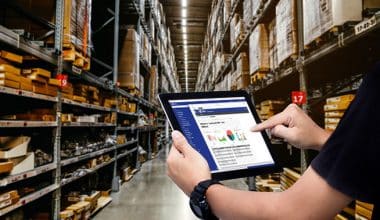Businesses that rely on multiple suppliers through manual processes may struggle to maximize the value of existing relationships in an ever-changing world. Changes in the corporate climate, an explosion of data, and shifting regulations all alter the landscape of supplier management. Manual processes will simply not be able to keep up. A supplier management system can transform processes, strengthen relationships, and make third-party management more seamless. Below, we outline the supplier management systems software process, some of the major benefits, and important features to consider when making the best tools selection possible solutions.
What are Supplier Management Systems?
Supplier management systems are the processes that ensure organizations get the most out of their supplier spending.
Suppliers are critical to a company’s success because they provide the goods and services required to meet consumer demand. As a result, proper management is required to avoid supply chain delays.
Managing suppliers also entails strategizing and establishing policies and contract agreements to ensure that both parties understand business expectations and goals. Furthermore, these standards establish metrics that indicate how well a supplier is performing and inform organizations about what they can do to improve their supplier’s efficiency.
Benefits of Supplier Management Systems
There are numerous advantages to having well-developed supplier management systems.
- Reduce Risks: Since business owners must maintain and evaluate supplier activity regularly, they will be able to detect any suspicious behavior quickly.
- Minimize Costs: By implementing a management system, executives can foster transparent and productive relationships with their suppliers. As a result, suppliers are more likely to offer discounts and savings.
- Increase Efficiency: Managing vendors improve communication, which means both parties have a better understanding of the business with which they are working. This will improve operational flow and reduce supply chain delays.
- Reduce Price Volatility: Suppliers frequently offer fixed prices in exchange for certain criteria, such as longer contract terms. Businesses can take advantage of this by managing supplier relationships and minimizing unpredictable price fluctuations.
- Supply Chain Consolidation: Effective supply chain management allows businesses to reduce the number of suppliers they work with, allowing them to streamline purchase orders and budgeting.
5 Important Characteristics of a Reliable Supplier Management System
We’ve discussed the advantages of good supplier management systems and how they can help your business. However, selecting a dependable system from the available options can be difficult. To assist you, we’ve compiled a list of the most important features of supplier management systems.
#1. Self-service and automated onboarding
All suppliers should be seamlessly and automatically onboarded using supplier management systems. Standardizing and visualizing this process not only increases efficiencies but also provides a better experience for third parties, kicking off the relationship on the right foot.
Working with complete and accurate supplier records is also essential for making sound business decisions. Depending on the number of suppliers, gathering this information can be a time-consuming, complex, and resource-intensive task.
#2. Usability and native integrations
Your supplier management system should be simple to use for your teams and should not necessitate a high level of expertise to set up. Individuals will not adopt the system if it is too difficult to use.
If your teams are already using specific platforms, the right supplier management system can alleviate change anxiety by natively integrating with the existing tech stack. Consider supplier management solutions that can be integrated with platforms like Salesforce and NetSuite.
#3. Risk intelligence feeds
Your supplier management system should assist you in identifying and mitigating the inherent risks that come with working with a new supplier. Existing risks in your supplier base must be constantly monitored and mitigated as problems arise. However, with supplier management systems, more can be done to reduce the amount of risk that enters your business in the first place.
#4. Powerful reporting capabilities
You should always be able to see an accurate snapshot of your supplier’s status. A supplier management system will provide your company with reporting capabilities that will allow you to drill down into your supplier base by category, type, and even supplier size.
#5. Collaboration tools
Supplier management systems are a complex process that should not be entrusted to a single business unit. Select a supplier management system that applies to the entire organization. It should enable your legal, procurement, and sales teams to effectively collaborate—as well as easily communicate with the suppliers themselves.
Supplier Management Tools
Before we get into each of these tools, let’s define what supplier management tools are and what they can do for you and your company. Supplier management tools include a variety of software that assists organizations in managing their supplier base and effectively interacting with them.
The key functions of supplier management tools are as follows:
- Supplier identification and registration
- Supplier contact information management, including addresses, emails, and phone numbers
- Orders placed with each supplier are tracked.
- Purchase order creation and management
- Invoice and goods receipt management.
- Delivery of detailed supplier performance reports.
Each of these functions is critical to an organization’s ability to manage its suppliers effectively.
Benefits of Supplier Management Tools
Using supplier management tools has several advantages. Here are some of the main advantages:
#1. Process automation
Nowadays, automation is essential for success. Many of the processes involved in managing your suppliers can be automated with the right supplier management tools. You will save both time and money.
#2. Enhanced efficiency
When a company can effectively manage its suppliers, it improves efficiency in all areas of procurement. Supplier management tools assist organizations in streamlining their procurement processes, making it easier to obtain the goods and services they require.
#3. Increased visibility
With good supplier management tools, organizations have improved visibility into their supplier base. This enables them to detect potential problems early and take corrective action. It also provides businesses with a better understanding of the capabilities of their suppliers.
#4. Improved vendor communication
Communication with vendors can be difficult without a clear supplier management tool. Businesses, on the other hand, can use such a tool to communicate more effectively with their suppliers, resulting in better supplier relationships and improved procurement outcomes.
Supplier Management Process
The 5-step Supplier Management process is outlined below:
#1. Establishing a set of business goals and objectives.
Before you begin your supplier management systems process, you must first identify the set of business goals and objectives for which suppliers are needed. It will highlight what third-party services each department requires so that you can map the relevant suppliers to each need without duplicating efforts and resources. These objectives will also aid in evaluating supplier performance about the objectives communicated to them.
#2. Identifying relevant selection criteria for supplier selection
Once you’ve identified the objectives and requirements that necessitate supplier engagement, you’ll need to define the selection criteria for selecting suppliers who will provide the best value for the money.
While the selection criteria vary depending on the type of organization and its supplier requirements, standard measures include pricing, past work quality, industrial recognition, legal reputation, and so on.
#3. Choosing and evaluating suppliers
The following step is to evaluate all relevant suppliers using your identified selection criteria. The majority of businesses judge suppliers based on the prices they have quoted. However, it is also critical to consider the other criteria you have identified.
Examine the quotations and proposals provided by potential suppliers to ensure you are maximizing cost-saving opportunities. Examine the terms and conditions to see how well the suppliers intend to meet the organizational needs. Simultaneously, ensure that you have conducted a thorough, holistic analysis of the suppliers’ strengths and weaknesses, as well as research into how the external environment’s threats and opportunities may impact your engagement with the suppliers.
#4. Contracting and negotiating with the chosen supplier (s)
Now that you’ve identified the appropriate suppliers, you must start the contracting process to finally bring them on board. Include all relevant stakeholders in the contracting process to gain valuable insights into how the contract can ensure maximum value delivery. In many cases, the contracting process is carried out by the finance/procurement team in collaboration with the senior executives of business units, while the groups that will work with the suppliers daily are not consulted.
#5. Assessing supplier performance
The supplier management process does not end once the suppliers are selected. Following their selection and onboarding, you must evaluate their performance regularly to ensure that they are meeting the set objectives and requirements. Make sure you have established KPIs to measure performance to ensure practical evaluation. This will also reveal areas for improvement to maximize supplier performance. It also indicates how effective our supplier management process is and how we can improve it.
Best Supplier Management Software
There are various types of supplier management software on the market, and choosing the one that best fits your organization is critical. The following is a list of some of the best supplier management systems software or tools used by several companies in 2023.
#1. SAP Fieldglass
SAP Fieldglass software is the first in line, a comprehensive supplier management tool with unique features and strong collaboration. It calls for advanced computerization. SAP Fieldglass enables businesses to manage their vendor network in all aspects, including contract management, performance tracking, and compliance. Its provision for hiring new vendors includes the Digital Partner Network, which assists businesses in hiring vendors with specialized skills.
Furthermore, SAP Fieldglass’s integration features are said to be one of its most impressive distinguishing features. It enables an open API framework, allowing for smooth workflow on various cloud applications such as Oracle, Salesforce, Kronos, and Microsoft Dynamics, among others. However, despite its many advantages, SAP Fieldglass is expensive and not suitable for all businesses.
#2. Gatekeeper
This VMS is appropriate for large enterprises that require widespread access and limitless storage. With over 200 contracts, Gatekeeper’s cloud-based system provides seamless vendor lifecycle management. Furthermore, it provides vendor requests, eSign features, and onboarding automation features for contract approvals. This VMS employs a Kanban Workflow Engine, allowing a company to streamline data entry and SLA management while also automatically building records.
It also provides customization options for creating and managing workflows, removing the need for manual processes. Because this VMS is entirely cloud-based, it supports over 220 different applications. However, the pricing is a little high because it offers tailor-made features for large enterprises.
#3. Genuity
With its numerous unique features and low pricing, Genuity is said to be best suited for IT companies, and it assists IT professionals in managing vendor relationships effortlessly. It offers customized, specific tools as well as IT tools with a simple interface. Many platforms, including AWS, Salesforce, Quickbooks, G Suite, and Azure, are easily integrated with Genuity. It also aids in the discovery of new SaaS vendors and the efficient management of existing vendors. However, Genuity has limited it to only IT and financial companies, making it difficult for non-IT companies to incorporate this VMS for vendor management.
#4. Precoro
Many small and large-scale businesses benefit from Precoro, a supplier management software. This VMS is appropriate for all industries and is among the most cost-effective software options on the market. It has an online portal for storing vendor contact information as well as generating performance reports and purchase requests using special procurement tools such as ideal budget management and purchase request tracking.
Furthermore, Precoro supports two types of integration: flat-file and automatic—both of which are supported on various platforms such as Xero, NetSuite, Quickbooks Online, and others. Precoro, despite its features, does not support direct vendor payment and lacks a compliance management feature.
#5. Cflow
Cflow by Cavintek is the final SMS on this list. It is a powerful cloud workflow automation tool with significant features that allow a company to streamline its procurement function and improve procurement performance. Some of the key benefits of using Cflow include efficient KPI tracking; the elimination of process redundancies; improved compliance management; enhanced supplier relationship management; enhanced visibility features for handling procurement processes; automated follow-ups; invoice approvals; reminders; and notifications for procurement orders; and the ability to create customized reports, allowing a company to gain deeper insights into performance.
Understanding the significance of supplier management systems tools and techniques is critical for every organization and is the first step in selecting the best SMS for your company. Using the right supplier management tool saves time, improves organizational efficiency, raises visibility, improves the procurement process, and protects a business from potential risks. Finally, good supplier management software boosts the company’s overall productivity.
What Is SAP Supplier Management?
SAP Ariba Supplier Management is an industry-leading, end-to-end solution portfolio that enables you to manage supplier information, lifecycle, performance, and risk in a single location.
What Is SRM Software Used For?
Supplier relationship management (SRM) software is a solution that assists businesses in streamlining supplier selection and onboarding, supplier performance tracking and evaluation, supplier document management, and other critical supplier-related processes.
What Are Some Good Supplier Management Practices?
The following are examples of best practices for successful supplier management:
- Developing business requirements
- Making a supplier database
- Supplier segmentation
- Increasing team knowledge.
- Defining responsibilities for each SRM team member.
- Putting in place a supplier management system.
Who Is Responsible for Supplier Management?
Supplier Manager – Process Owner
The Supplier Manager is in charge of ensuring that all suppliers provide good value for money. He ensures that supplier contracts support the needs of the business and that all suppliers meet their contractual obligations.
What Is the Importance of Supplier Management?
It is critical to properly manage suppliers to limit financial, business, and reputational risk. This, according to Gartner, is a process that “enables organizations to control costs, drive service excellence, and mitigate risks to gain increased value from their vendors throughout the deal life cycle.”
What is supplier Quality Management?
Supplier quality refers to a supplier’s ability to deliver goods or services that meet the needs of customers. Supplier quality management is defined as a system for managing supplier quality proactively and collaboratively.
Conclusion
Supplier management systems can be extremely beneficial to companies of all sizes and industries. Adopting these tools can help organizations improve their efficiency, reduce human error, and eliminate manual processes that waste time and money.
There are a plethora of tools available, but we discovered that SAP Fieldglass is the best supplier management software overall due to its robust features, advanced automation capabilities, integrations, ease of use, and industry recognition. It’s an all-in-one solution that can handle all of your supplier management needs seamlessly, with a short learning curve and excellent support along the way.
Supplier Management Systems FAQs
What are the types of vendor management systems?
Vendor Management System Types
- Procurement. Aids in the management of due diligence processes when selecting vendors and purchasing services.
- Vendor Onboarding. Supports enrollment, registration, and managing access and permissions for new vendors within the system.
- Vendor Risk Management.
- Relationship Management.
How important is the supplier management system?
A good supplier management process not only allows you to get the most out of your business requirements but also gives you a competitive advantage. It enables you to save money by improving the quality of your goods and services, which affects your bottom line.
What is SRM software used for?
Supplier relationship management (SRM) software is a solution that assists businesses in streamlining supplier selection and onboarding, supplier performance tracking and evaluation, supplier document management, and other critical supplier-related processes.
References
Related Articles
- Procurement Management System: Types and List of Top Software Options
- Project Procurement Management: Detailed Guide To The Procurement Processes
- BARGAINING POWER OF SUPPLIERS: What It Is & How It Works
- ACCOUNTS PAYABLE PROCESS: How to Manage the Process Effectively
- SUPPLY CHAIN FINANCE: Definition, Management, Difference, and Companies






